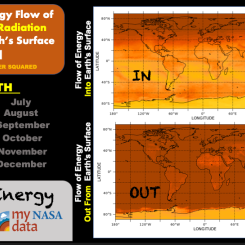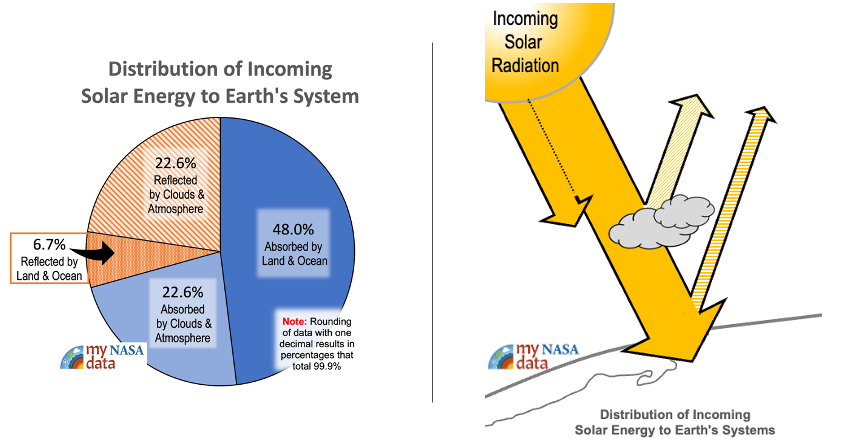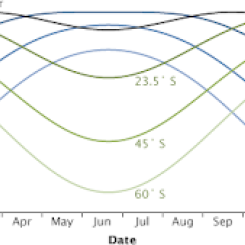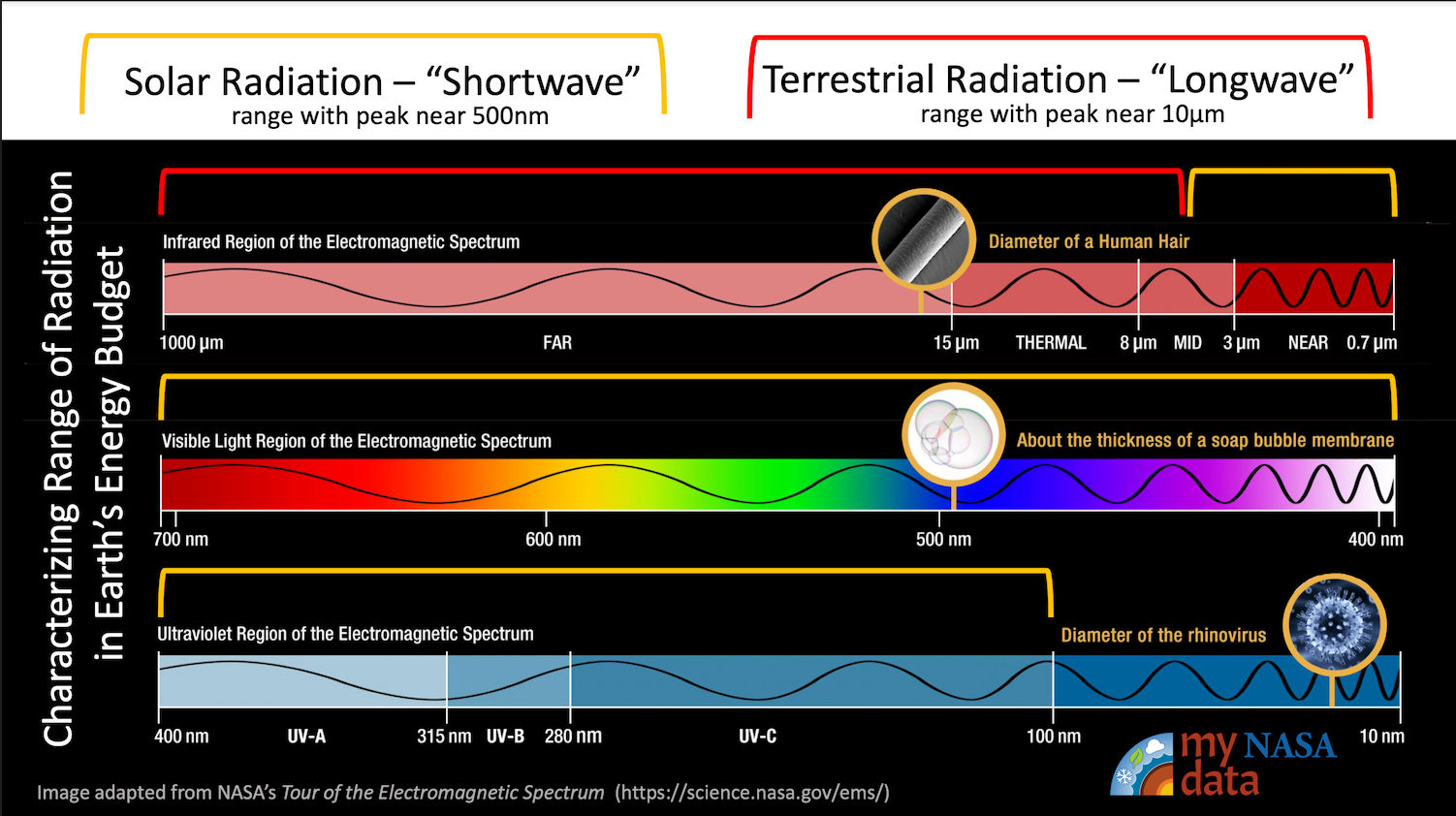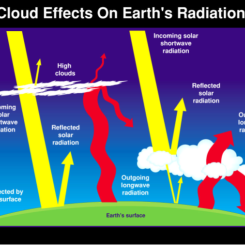Lesson Plans
Energy Transfer in Earth's Atmosphere
Overview
Students will examine how radiation, conduction, and convection work together as a part of Earth’s Energy Budget to heat the atmosphere. They will further explore Earth’s Energy Budget through a set of animations and create their own energy budget that includes their school and surrounding area. As an extension, students will analyze a diagram of Earth’s Energy Budget designed by NASA and answer critical thinking questions to check for student understanding of the content.
Materials Required
Procedure
- To start the lesson, show the students the following NASA Animations:
- Explain to students that these animations show how Earth’s solar radiation is reflected or absorbed in Earth’s atmosphere. Clarify that the Sun is Earth’s heat source and energy from the sun travels to Earth through electromagnetic waves to Earth’s surface. That energy gives off heat that is then transferred into other forms of heat energy, namely radiation, conduction, and convection.
- Next, show students the video Real World: Monitoring Earth's Energy Budget with CERES. Check for student understanding by asking the class the following questions after the video:
- NASA uses CERES, a data collecting sensor on satellites, to measure what variable?
- How much of the Sun’s solar radiation is reflected back to space or absorbed by Earth’s atmosphere and clouds?
- What absorbs the remaining radiation?
- True or false: Darker surfaces tend to absorb more energy, whereas lighter surfaces tend to reflect more energy.
- Following the video, pass out the student handout Energy Transfer in Earth’s Atmosphere Cloze Notes.
- The teacher will go through the Google slides Energy Transfer in Earth's Atmosphere and elaborate on the content of each slide.
- Students will fill in the cloze notes as the teacher goes through each slide.
- To check for student understanding, the teacher can ask the questions below:
- Explain in your own words what is meant by the term “heat transfer”.
- Describe how radiation, conduction, and convection work together to heat Earth’s atmosphere.
- What is meant by a “balanced” Earth’s Energy Budget?
- Differentiate between shortwave and longwave radiation.
- As an assignment, explain to students that they will be creating a diagram of Earth’s Energy Budget including their school and the surrounding area. The diagram requirements are listed below:
- Make sure to draw the Sun somewhere at the top of your paper.
- Draw any clouds that you see in the sky.
- Think about the geography of the land surrounding your school and sketch it. Is it hilly and mountainous or is the land flat?
- Draw your school on your paper. Make sure to label the parking lot and draw any vehicles found there.
- Next, think about any other surfaces found outside or near your school. Are there grassy areas, trees, or plant life? Is your school next to a body of water?
- After you have labeled the surfaces, draw any buildings, homes, or businesses that may be nearby.
- Draw the roads or highways that lead up to your school.
- Now that you have drawn your school and the surrounding area, think about which structures will absorb the sun’s energy and which surfaces will reflect the sun’s energy. Remember from today’s lesson:
- Dark colors absorb a lot more heat than lighter ones because they absorb more light energy.
- Lighter regions are reflective and absorb less of the Sun’s energy.
- Using a yellow colored pencil, draw solid arrows from the sun to each structure or surface that will absorb the sun’s energy.
- Lastly, with the same colored pencil, draw dashed yellow arrows from any structure or surface on your diagram outward towards space that will reflect the sun’s energy.
Answer Key:
Teachers who are interested in receiving the answer key, please complete the Teacher Key Request and Verification Form. We verify that requestors are teachers prior to sending access to the answer keys as we’ve had many students try to pass as teachers to gain access.
Disciplinary Core Ideas:
- PS4A: Wave Properties
- ESS2A: Earth Materials and Systems
Crosscutting Concepts:
- Structure and Function
- Stability and Change
Science and Engineering Practices:
- Developing and Using Models
- As a homework assignment or extension activity, have students analyze NASA’s Earth’s Energy Budget diagram.
- To check for student understanding of the diagram, ask students to answer the following questions:
- Define the following terms found on Earth’s Energy Budget diagram:
- Absorb:
- Reflect:
- Identify the objects in Earth’s atmosphere that are absorbing and reflecting the Sun’s energy.
- Latent heat in water vapor carries a percentage of what back into the atmosphere?
- List the amount or radiation in Wm² that the following objects emit:
- Atmosphere:
- Clouds:
- Surface:
- By looking at Earth’s Energy Budget and reviewing today’s class notes, explain how the energy budget can become imbalanced.
- Predict what will happen to Earth’s Energy Budget if the amount of greenhouse gas emissions continue to rise in the Earth’s atmosphere.
- Define the following terms found on Earth’s Energy Budget diagram:
- Internet Required
- One-to-a-Group

